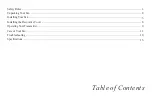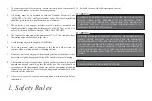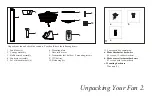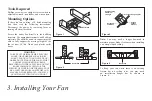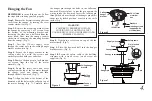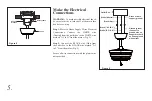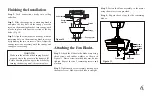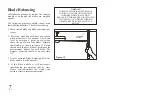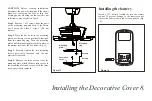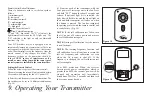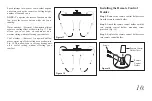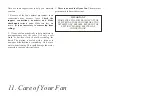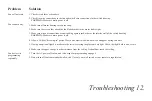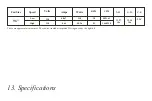
9. Operating Your Transmitter
Figure 16
Figure 15
b) From the back of the transmitter, with the
fan’s power off, restore power to the fan. Press
and hold “SET” button for about 5 seconds and
release. If optional light kit is installed, the
light kit will flash twice and the signal light on
the hand held transmitter will come on when
the button is pressed. The fan has completed
the pairing process with the remote control and
is ready for use. (Fig. 16)
NOTE:
If the self calibration test failed, turn
the AC power off; restore power and process
the self calibration test again.
NOTE:
During self calibration test, the remote
is non-fuctional.
NOTE:
The learning frequency function and
self calibration test will continue to retain the
last set frequency and calibration set even
when the AC power is shut off. If the
frequency is changed the self calibration test
will occur again.
Over 80W protection: When the receiver
detects motor power consumption which is
greater than 80W, the receiver power will be
stopped and operation will immediately
discontinue. Wait for 5 seconds and then turn
the receiver power back on.
Remote Control Button Definitions:
These six buttons are used to set the fan speed as
follows:
I = minimum speed
II = low speed
III = medium low speed
IV = medium speed
V = medium high speed
VI = high speed
button: Turns the fan off.
button: Controls fan direction.
"D" and "ON" dip switch: The "D" selection is the
light dimmable selection for LED light only. The
"ON" selection is the light on only (no dimmable
function). (Fig. 16)
Your DC brushless motor is equipped with an
automatically learned type remote control. There are
no frequency switches on the receiver; the receiver
unit will automatically scan the frequency from the
remote control if any changes are made. The
frequency settings on the transmitter should be
changed
ONLY in case of interference or if a
second or more ceiling fans with the same type of
control system are installed in the same structure.
Setting the Remote Control
Follow the below steps to set the remote control:
The auto learning function will only mandate within
60 seconds when turning the fan’s AC power ON.
a) Select desired frequency from the transmitter. The
dip switches can be set to 16 different combinations.
(Fig. 16)
ON ECE
1 2 3 4
ON ECE
1 2 3 4


